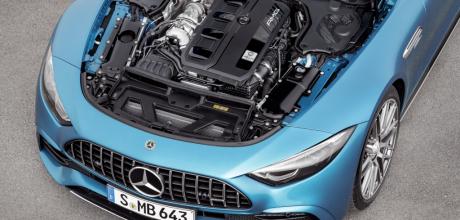AMG’s new generation turbo changes the game with Formula 1 technology
Turbochargers have come a long way since 1962 when an Oldsmobile arrived on the market with a forced induction engine dubbed JetFire. No longer a rarity, cars that don’t feature a turbocharger are now the outliers in modern motoring, with everything from a Kia Picanto to the fastest hypercars on the planet making use of turbo boost. Once a go-faster icon, the humble turbocharger is often deployed to improve fuel economy. But that’s not what we are focusing on today.
BACK SECTION. TECH TALK ELECTRIC TURBO
ELECTRIC CHARGE
How a new design cold benefit one of the oldest go-fast tricks in the performance book.
Since that early ’60s automotive debut there have been significant steps forward in the turbocharging world. In 1973 BMW paired the tech with fuel injection for the first time in the 2002 Tii Turbo and in 1988 the Honda Legend debuted variable geometry turbocharging. Well, add 2022 to the history books, with the Mercedes-AMG SL43 and C43 putting electric exhaust gas turbochargers into mainstream road car production for the first time.
Built in partnership with turbocharging gods Garrett, the new turbocharger system allows AMG to fit larger, more powerful turbos to its cars, while reducing the impacts of that pesky nuisance, lag.
It does this by splitting the turbocharger wheel and compressor wheel (yes, like they do in Formula 1), and fitting a four centimetre thick ‘pancake’ electric motor that produces 6kW in between. This allows the electric motor to spin up the turbine without the need for exhaust gases to increase low-rpm power and response. The real party trick comes off-throttle however, with the electric motor keeping the turbocharger spinning on boost like an anti-lag system until the driver applies the right pedal once more.
Going into production for the first time, the electric turbo is fitted to a variant of the 2.0-litre four-cylinder engine (dubbed M139L) that we know and love in the A45 S hyper hatch. In the C43, mounted north-to-south, the M139L which features the turbocharger produces 300kW (at 6750rpm) and 500Nm (at 5000rpm).
It’s worth noting this is just a starting point for the technology in AMG’s performance models. Affalterbach will really start giving the boost dial a workout with the next-generation C63, where it will put the technology to the test with 40psi (2.8 bar) of maximum boost pressure. If the steady increasing of power from the M177 4.0-litre V8 is any indicator, that means we are only at the start of a very long and enjoyable upward trajectory.
TIME BOOST
Linking both the first ever turbocharged production engine and AMG’s new tech is Garrett. The American company partnered with GM to develop the JetFire in ’62.
HIGH VOLTAGE
Driven by a 48-volt architecture, the AMG turbo can spin at up to 175,000rpm, which is nearly 3000 rotations per second. Dare you to put your finger into that!
HEAD START
This new electric turbo differs from AMG’s ‘53’ models as it retains its exhaust side housing, though the engine still mates with a belt-driven starter-generator.
FAMILIAR FACE
Racing fans will be aware of a similar technology to what AMG is putting in production from the MGU-H (short for Motor Generator Unit — Heat) currently used in F1.
BELOW AMG M139L will make its Australian debut in the SL43, being followed in short order by the C43, then C63
THE REAL PARTY TRICK COMES OFF-THROTTLE, WITH THE ELECTRIC MOTOR KEEPING THE TURBOCHARGER SPINNING ON BOOST LIKE AN ANTI-LAG SYSTEM


